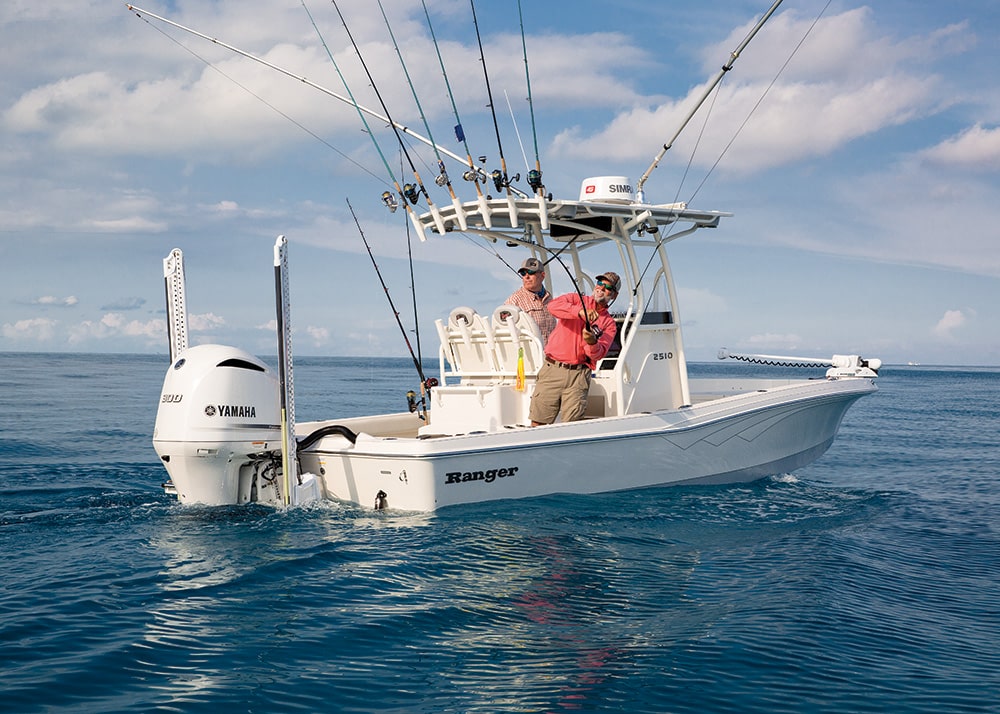
Perhaps no other style of boat has as many varying demands made on it as does the coastal fisherman under 26 feet.
Forty-two percent of our survey respondents preferred a boat in the 21- to 24-foot range. Among current boat owners, 25-feet was the ideal size, while among first-time buyers, 22.9 feet was the median for consideration.
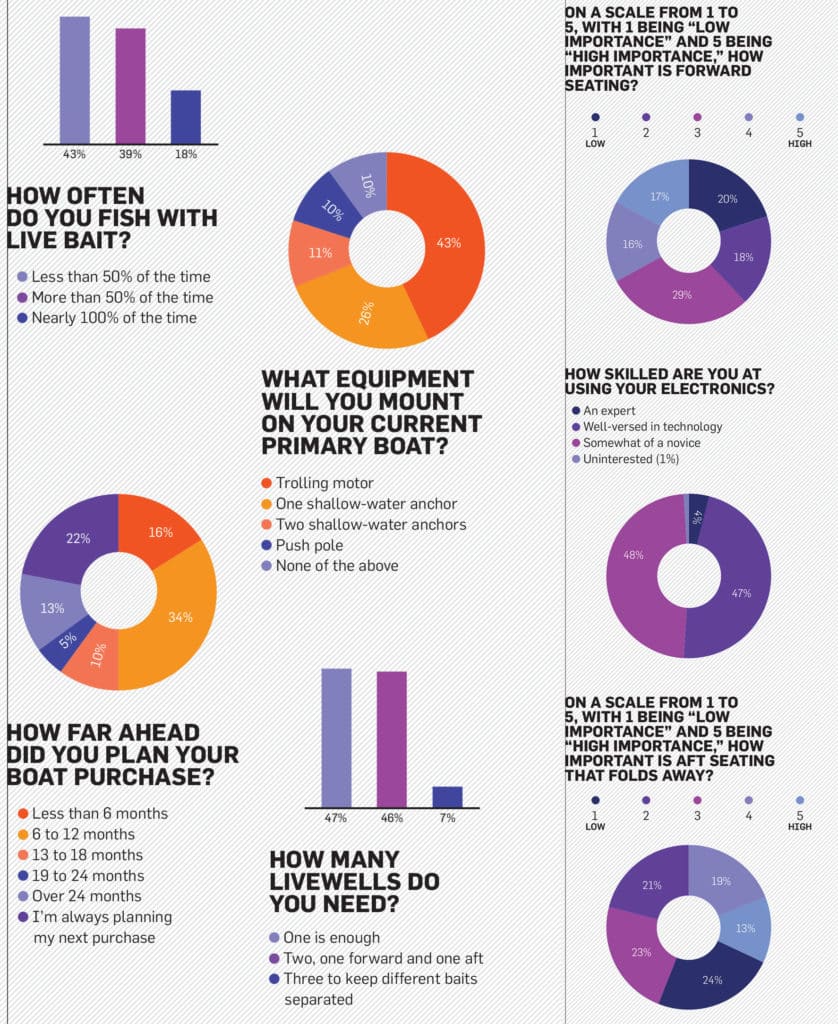
Overall, respondents were about evenly split as to the type of fishing they enjoyed, with 47 percent most interested in fishing bays, flats, wrecks and reefs, and 51 percent expressing a -preference for offshore fishing.
While this category includes smaller center-consoles—often scaled-down offshore models—and dual-consoles, which excel when buyers are willing to sacrifice dedicated fishing features for a family-focus, clearly the king of the versatile midsize boat, built for inshore fishing, capable of safe offshore ventures, and is family-friendly, is the bay boat.
“If you can get one boat to do it all, that’s where it’s at,” says Capt. Larry L. Jett, manager of saltwater business for Ranger Boats. “We take that into consideration and recognize that you buy a bay boat for a range of fishing and family use.”
To wit, 61 percent of survey respondents said “to fish more” was their primary purpose in buying a boat; 62 percent want a hardcore fishing machine; 36 percent felt that the company of family and friends was an important consideration; and 38 percent were after a multipurpose boat.
The bay boat checks all of those boxes.
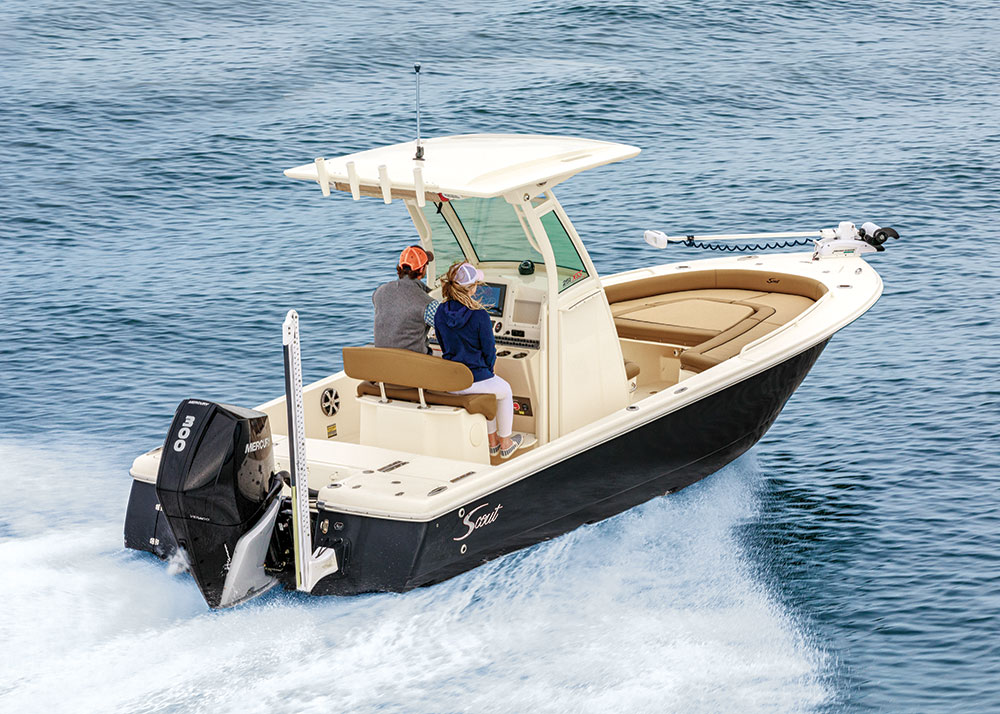
Do It Right
By Glenn Law
Boat shows and dealership -showrooms are great places to drool, with one hand on your checkbook, but a wise decision takes some time and thought.
The comments made by our respondents regarding the correct approach to finally making a purchase boiled down to simple and straightforward advice: “Fish the boat”; “Talk to people who own the boat you are considering”; and “Do some in-depth sea trials.” In short, “Do your research” was the overwhelming advice expressed by survey respondents and experienced buyers.
When making the buying decision, quality and durability are important considerations, and well worth paying for initially because the median age of bay boats owned by survey respondents was nine and a half years.
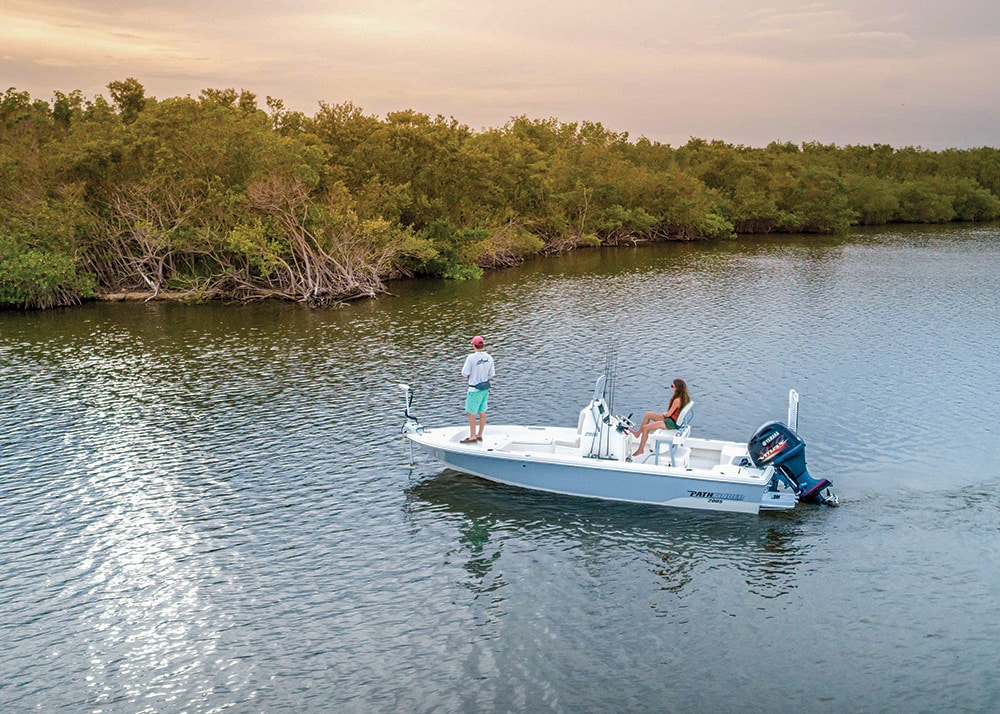
It makes sense to choose a manufacturer with a stellar reputation.
If all you want a boat for is to fish, your choices are simplified: Add nothing that doesn’t contribute to the chosen mission.
If, on the other, that mission is split, or diversified—as is nearly infinitely -possible with bay and inshore boats—then the buying choice requires a fair amount of well-considered choices.
The first step in a boat-buying -decision defaults to determining what kind of -fishing you want to do, and how you will use the boat.
Those decisions clarify the type and model in your sights; next comes zeroing in on the particulars that put those goals within reach. This is where abundant research, sea trials and simply looking at as many boats as possible that fit your desired parameters come into play.
Accommodations
Deciding on interior layout and seating becomes a primary consideration.
“A lot of our customers are not sure what they want,” says Alan Lang, director of sales and marketing for Scout Boats.
“Do you have kids? How many people will you typically carry? Is a head important? How are you going to use the boat?”
If fishing is paramount, look no further than the signature fore and aft casting decks that typify the bay-boat design. If your boat will share its fishing time with entertaining, then comfortable seating for nonanglers becomes more important, perhaps even if compromising fishability.
Our survey revealed that interest in forward seating was mixed: A third of respondents considered forward seating of moderate importance, and another 20 percent of low importance. Only about 20 percent considered it high importance.
Cockpit space was most important to 73 percent of our survey respondents.
A tribute to bay-boat versatility, no single layout eliminates options. “While our 2350 Bay Ranger has a full back seat in it,” Capt. Larry L. Jett says, “you sacrifice the rear of your boat to comfort.”
But that might be of little consequence. “We find that most inshore fishing is done from the front of the boat,” he says.
Storage
Our survey indicated that second behind safety and comfort, onboard storage was the priority for buyers.
“Experienced boaters know what they need in terms of storage,” says Jeff Vaughn, VP Sales, marketing and service for Boston Whaler. But the company configures its storage so even those who haven’t had the time on the water to determine their needs won’t be caught short.
“Everyone needs dry, protected -storage,” Vaughn says. “All of our storage areas are finished in class-A condition and drain overboard. They are foam-insulated so they can be used as a fish box,” which allows for versatility.
Bear in mind: The more dry storage aboard, the more options you have in how it’s utilized. Dry storage may be used for storing wet items, but wet storage will never keep things dry.
Tools of the Trade
Efficient rod storage is extremely -important in this class of boat, and it needs to be carefully designed to keep gear out of the way when playing, yet handy to fire off a cast when fish are sighted.
Because of the day-use nature of bay boats, the majority of respondents found locking storage unimportant. Still, 27 percent carry three or four rigged outfits for a day’s fishing; 65 percent pack along five to 10 outfits; and 7 percent carry 11 or more.
Before you buy, consider how much rod storage is enough for the kind of fishing you plan to do, and make sure you have enough for efficiency and safety of -passengers and tackle alike.
Gunwale rod holders are standard issue on any fishing boat, but supplementing them with additional holders, placed where they suit your fishing style, is -always an option you should consider.
Only a quarter of survey respondents used more than four gunwale-mounted rod holders.
But among bay-boat owners who -routinely fish offshore, over 80 percent felt that they need up to six gunwale-mounted holders.
Rocket launchers—either on a seatback, leaning post or T-top—offer a-dditional safe storage, and is an option worth -considering.
Scout’s Lang says: “Rocket launchers are not always standard, but we see a lot of them added on a new boat. They also help with the aesthetics.”
Aesthetics might seem superfluous, but pride in ownership plays a big part in -buying the right boat and impacts resale.
Styling shouldn’t be underrated when envisioning the boat you see yourself in.
Livewells
Both standard and essential, livewells and inshore boats go hand in hand. The configuration, capacity, number and purpose of those, however, vary as widely as styles of fishing and geography.
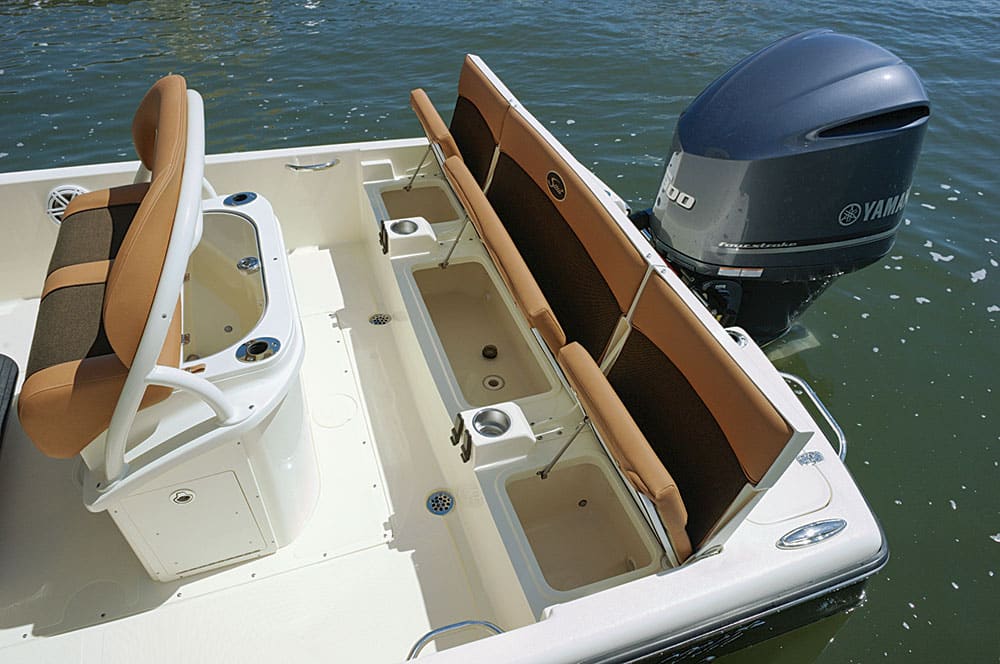
Two-thirds (68 percent) of survey respondents routinely carry a few dozen live baits on a typical fishing trip, and only 24 percent usually carried less than a dozen. For that 24 percent, a single small well might suffice, but when live bait is your game and the success of the day depends on keeping baits healthy and frisky, additional wells or additional capacity become essential.
Editor’s Tip: Don’t underestimate the convenience and versatility of the livewells. One fore and one aft should be the minimum. It’s a pain to have to walk the length of the boat for a fresh bait in the heat of the action. The days when you need only one will be far outnumbered by those days when the added convenience of a second well makes life easier.
Forty-eight percent of our respondents felt that a single well serves their needs, with 45 percent preferring to have one well forward and another in the stern.
Many of these decisions are based on where you live and how you fish. Large capacity, strong flow and the option to recirculate water in the well are all important when frisky live baits are the mainstay of a successful day.
If a dozen pinfish and a few dozen live shrimp are all you need, a small well in the stern and a crustacean well in the bow will certainly be adequate. Livewells are a subjective and personal decision.
“We have different options based on different fisheries,” Jeff Vaughn explains. “In southwest Florida, a larger well is more desirable. In the Northeast, we don’t use livewells; a livewell is used for trash. We try to match the livewell configuration in our boats to the market area—the place the buyer will most often be fishing.”
Power Up
Fuel efficiency and range, as well as a comfortable, solid ride, topped the list of important considerations; 63 percent of survey respondents agreed.
A solid, secure ride depends on the hull design as well as -construction. Suffice it to say, top builders leave nothing to chance here, which leaves fuel efficiency and range a variable, both of which are a function of the outboard power and fuel capacity.
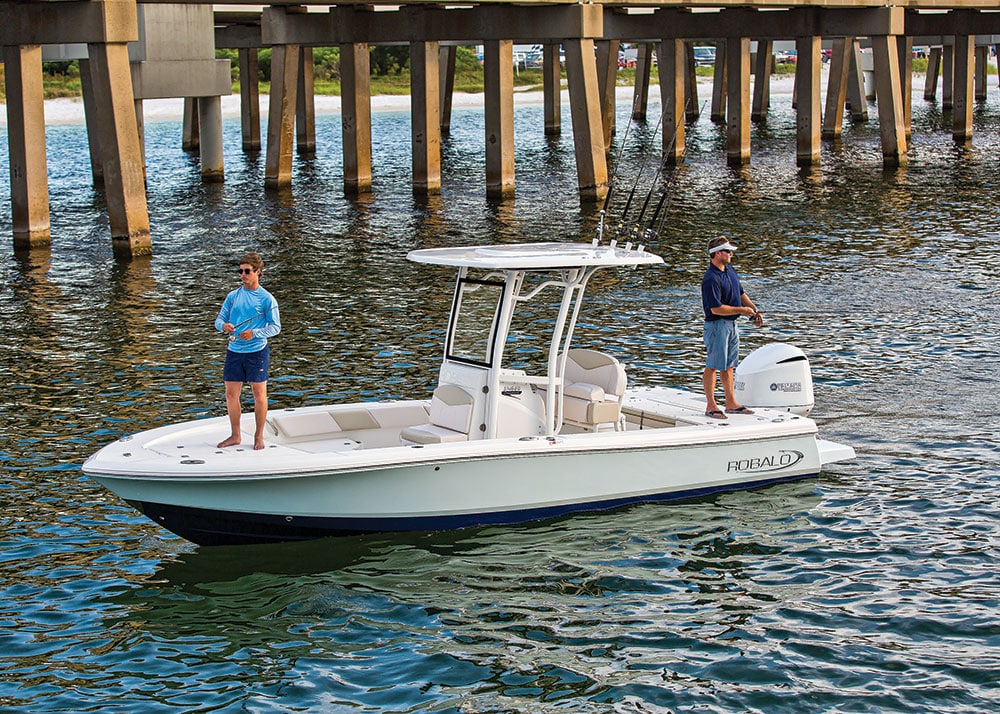
All boats are rated with a maximum horsepower allowance for that particular hull. But just because you can doesn’t necessarily mean you should. Powering to the max certainly gives you top speed, but that’s not always the most important consideration. Fewer than 20 percent of those surveyed ranked maximum speed as the most important considering when choosing a boat/motor combination.
Hanging the largest possible engine off the transom will certainly give you speed, and perhaps a shorter time to jump on plane, but the additional weight of a larger engine might not be worth the limited benefits. More power might allow you to cruise at a lower rpm, but that has to be balanced against a possible decrease in range, depending on the fuel-consumption differential between maximum -horsepower and acceptable horsepower.
Jordan DeLong, director of marketing for Contender Boats, explains that while the company’s bay boat is rated for 400 hp, “the most popular motor on our 25 Bay is the 300 Yamaha, due to the weight and reliability. And you don’t lose much speed. That engine runs superbly in the -mid-60 mph range. Most of the time you don’t want to go much faster than that.”
Mechanical Systems
Gone are the days when stainless fittings and sound constructions were considerations. In a competitive market, subpar execution writes its own demise.
However, an additional set of -mechanical considerations has emerged, with once-luxury-but-now-standard -accessories such as shallow-water -anchoring systems and trolling motors.
Within our polled sample, 67 percent of current owners’ boats are equipped with a trolling motor. Forty-two percent are fitted with a shallow-water anchoring system, and 17 percent have a pair of them.
Our survey indicted that 65 percent of buyers want their boat fully equipped with the option of choice at purchase, a growing trend among buyers.
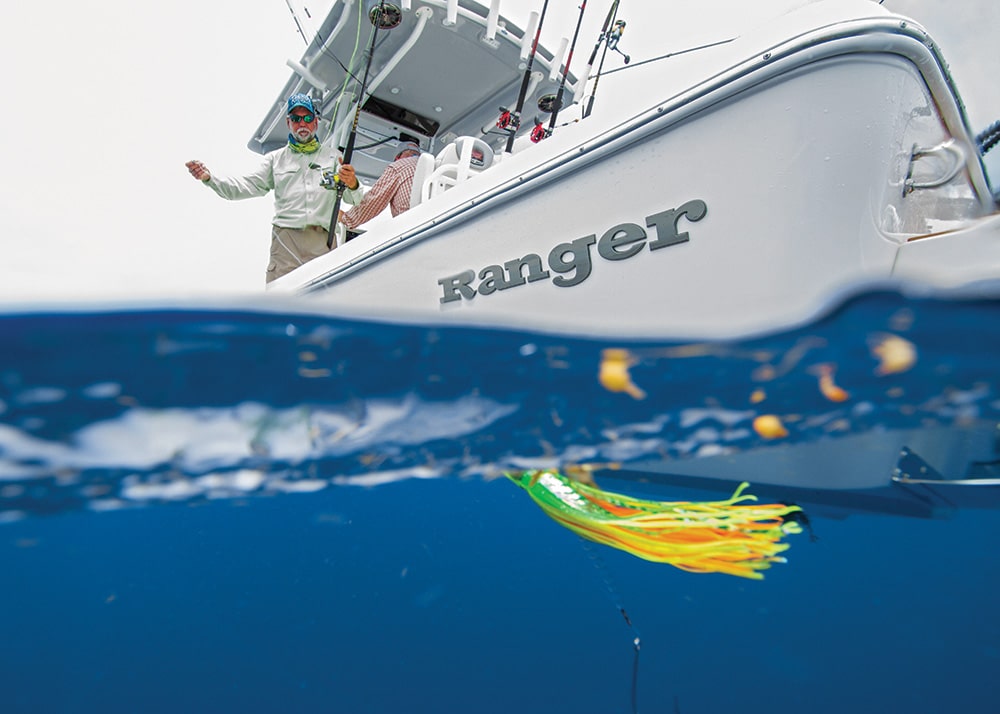
Those who choose to add the gear later would do well to set up the boat properly, with backing plates and wiring in place and accessible.
“One thing we do at Scout is install Deutsch waterproof connectors on our wiring harness,” Lang says. That makes it easier on the dealer’s additions later, and for the owner, it provides a -plug-and-play installation.
Electronics
Right along with livewells, electronics is a personal choice and a highly customizable feature. Sonar leads the list of popular installations, with 83 percent of owners having it or planning to purchase it. A VHF radio/essential safety is second in popularity, with 67 percent of respondents having it on their boats.
The formerly minimalist layout of the bay-boat helm is rapidly expanding, as buyers opt for more and bigger multifunction displays and wider variety of electronics. Traditionally a 9-inch screen was large on a bay boat, but that’s changing.
“We are putting more and more space at the helm for bigger screens,” Vaughn says. “There is a lot of customization at the helm, and we make sure we provide enough space to make that easy to do.”
Overall, the trend in electronics is to replicate what is on larger boats, from side-scan sonar to radar.
“The movement is the bigger the -better,” DeLong says. “Our boats have up to 16-inch MFDs. We get lots of requests for dual sounders—chirp and such.”
Buyers are also trending toward -purchasing electronics with the boat, rather than adding specific items later.
“Over half of our boats go out with -Raymarine electronics,” Vaughn says.
As well as simply getting what you want when you buy the boat, having a factory-installed electronics suite allows servicing or replacement later to be much simpler— and more economical.
“People are increasingly buying all their electronics with the boat,” DeLong says. “Our electronics installations have increased. We see a real trend in factory installations, and we like it that way. It keeps other hands—over which we have no control—off the wiring when there’s one group of people who touch it.”
Editor’s Tip: One the lessons learned by experienced boat buyers, as opposed to first-time buyers, is the importance of getting what you want with the initial purchase. Planning to add desirable features later sounds good, but every week your boat is in the shop, or under renovation, is one less week you have it to enjoy on the water.
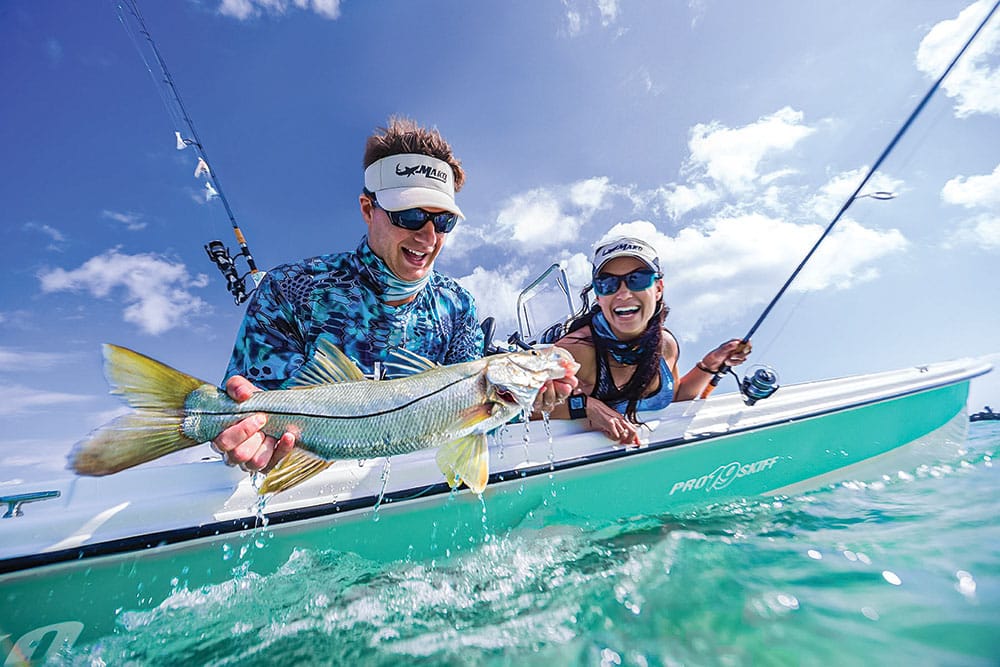
Shallow Ventures
By Alex Suescun
If you find sight-fishing in shallow water for fabled inshore game like bonefish, redfish, permit, snook, striped bass or tarpon especially appealing, a flats boat or technical poling skiff is the right choice for you. Not only do they float shallower than other boat types, but they also superbly negotiate tight quarters in coastal creeks, marsh bayous and backcountry lagoons. The fact that they’re a breeze to trailer, can be stored in a garage, and require less horsepower are major bonuses, especially for the budget-minded.
Pole or Troll
Should you plan to focus primarily on stalking species that forage in water a scant few inches deep and are endowed with seemingly supernatural powers of detection, a poling skiff will be hard to beat. Boasting a narrower, -more lightweight hull than a flats boat, a poling skiff is designed to draw less than 8 inches of water and glide stealthily—with no hull slap to alert fish in the vicinity—propelled by a push pole, as the name implies, while the occupant tracks down their target. It can also turn easily with a stroke of the push pole to quickly respond to the quarry’s sudden changes in course.
The Maverick 17 HPX-S, Yellowfin 17 Skiff and Spyder FX17 Flicker are good examples, providing the desired shallow-water performance, and equipped with spacious fore and aft casting decks, poling platforms, and all the necessities for what amounts to skinny-water hunting.
Flats boats still draw less than a foot, but they aren’t meant just for poling. In fact, it’s common to see anglers fishing shorelines, channels, docks and jetties aboard flats boats propelled by a bow-mounted trolling motor, which allows greater water coverage in less time.
The popular Hewes Redfisher 18 or -Carolina Skiff’s JVX CC Series exemplify the flats-boat category, offering more versatility—a desirable trait among inshore boaters surveyed. Along with its bigger footprint comes more storage, fishing room and seating; increased stability; a larger fuel capacity—which translates to greater range—and more amenities, like a bigger or additional livewell, sizable insulated fish box/cooler, and perhaps rod lockers; and integrated spray rails or a pronounced bow flare to mitigate sea spray.
Benefits and Limitations
Venturing way up the flats or deep into the backcountry—far from the Intracoastal Waterway and other high-traffic, high-fishing-pressure areas—is perhaps the greatest benefit flats boats and poling skiffs afford. Some models incorporate a tunnel or transom pocket in their hull design, enabling you to run shallower with the motor—and propeller—trimmed higher. Others accomplish the same with a hydraulic jack plate, which raises the outboard vertically and also helps takeoff in shallower water.
Of course, knowing how much water your flats boat or poling skiff draws is crucial to avoid getting stranded far from the nearest channel when the tide ebbs or a strong wind blows all the water out of the flats or marshes you’re fishing.
Going by a boat’s published specs could prove costly. There’s no regulation -dictating how boatbuilders must measure draft, so some list that of the empty hull; some the draft of the boat with motor, fuel and actual fishing-situation load; and others fall somewhere in between. As you narrow down your boat choices, contact the builders to learn how each measures draft. Then ask boat owners for their real-life -assessment before finalizing your short list.
Editor’s Tip: Shallow-water access was essential for 15.7 percent of surveyed flats- and bay-boat owners, but a lightweight, shallow-drafting boat isn’t always better. If you don’t fish only shallow flats, or must cross open water to reach the fishing grounds, a hull with a bit more heft and somewhat of a “V” at the bow will make the ride more comfortable.









